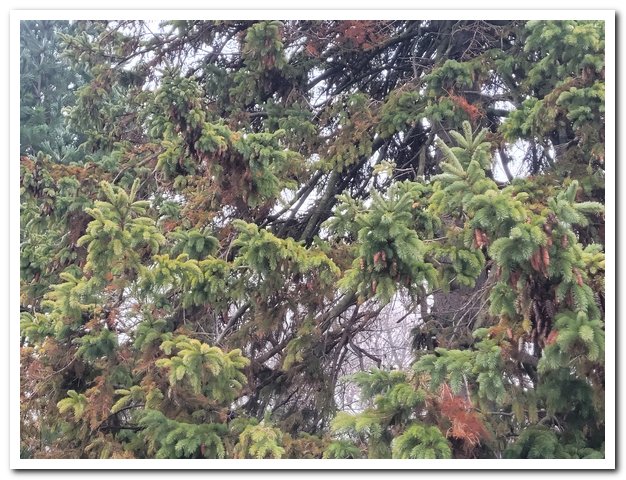
Hello Toronto Master Gardeners,
Our Black Spruce normally gets brown needles on the inside, which fall off. This is not an issue, normally. But now, there is much more blastiness all over the tree. Kindly see attached. Is this just a normal process maybe exacerbated by such a long warm season? I’d hate to call the City because their first reaction is to cut. We’ve been feeding and watering this tree for 23 years and will do what we have to, to save it. I will attach a second, close up picture separately.
Thank you for writing us regarding your Black spruce (Picea mariana), a conifer native to Ontario.
In fact, Black spruce trees grow across the breadth of the North American boreal region, that is, above the temperate southern regions, but below the tree-less arctic zones. Over 80 per cent of its global range is in Canada, in mixed forests of black spruce, fir and balsam. The slow-growing, majestic, Black spruce primarily thrive in cold, low, soggy areas, such as bogs and swamps. Hence common nicknames are ‘swamp’ or ‘bog’ spruce,
Also, Black spruce are rarely found as a planted species, the more usual favourites being Colorado blue spruce (Picea pungens), or Norway spruce (Picea abies). Black spruce, as seen by their growth range, have only a medium tolerance of warm or hot temperatures. So perhaps your concern re a “long, warm season” in our Toronto area is well-founded.
As to what problems typically effect spruce, the options might be:
(1) spruce budworm, which prefers to eat the upper crown, and ties needles together with silk, but no evidence of this in either of your images;
(2) spruce spider mite, but then, again, you would see fine webbing on the needles;
(3) cytospora canker, where sap seeps, and entire branches are affected, usually caused by drought, but your tree’s brown needles are not limited to certain branches, but spread throughout;
(4) needle fungus, where needles turn brown and fall off — known as ‘needle cast’, while current year growth is strong and healthy. This could be the cause of the “blastiness” you refer to. Plant fungi thrive in undisturbed, warm, moist habitats, so you may consider pruning a few lower branches at ground level, to promote circulation of air throughout the tree interior. While your ground watering is very important, southern Ontario’s hot, humid and rainy spring/summer conditions could promote growth of blight and fungus.
But first, for your further reading on the subject, attached here is a detailed report that clearly describes 3 of the most common fungi that attack conifers: Rhizosphaera, Stigmina, and Lophodermium, and well as several other possible spruce needle fungi.
Regarding the City of Toronto, if your tree is actually on City property- we do recommend calling them first.
Otherwise, if the tree is on your property, a consultation with an arborist would give you both a professional, in-person diagnosis as to what is ailing your spruce, and, if a fungicide is advised, a confirmation of which might be currently legal in Ontario; further, they could be best equipped to undertake the treatment. Toronto Master Gardeners recommends contacting Landscape Ontario or ISA Ontario to help with hiring an arborist.
Hopefully this will be of some help, to improve the health of your 23-year-old friend!

